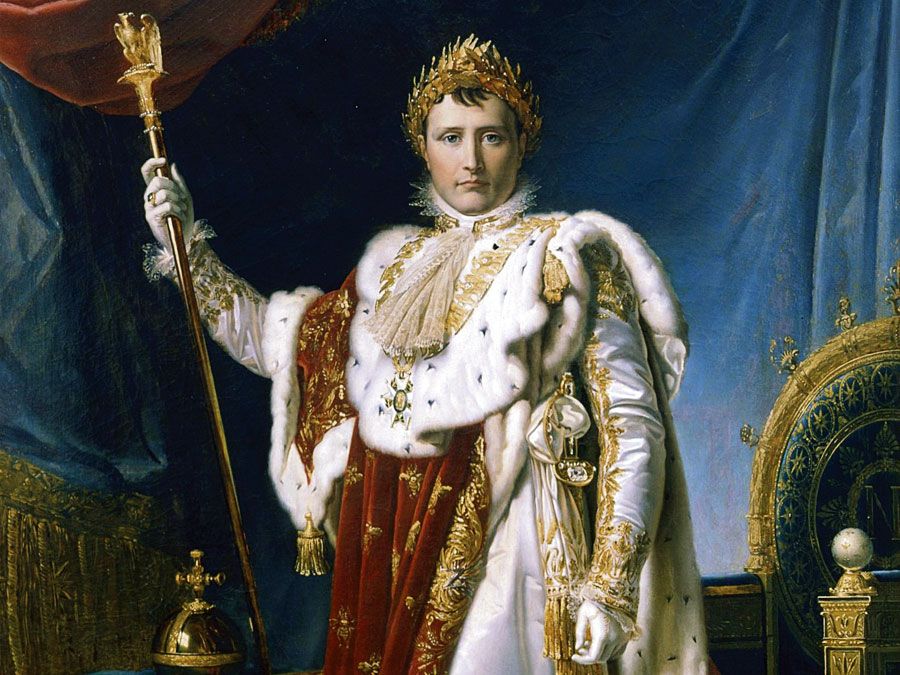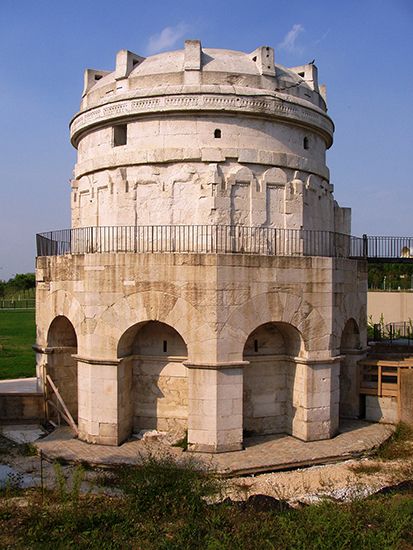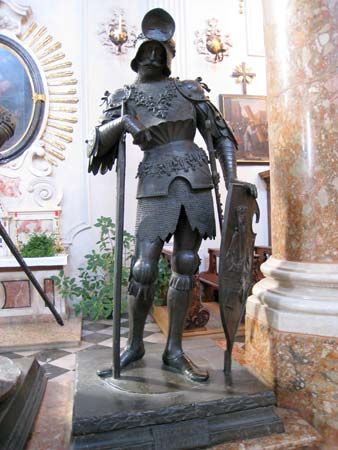Theodoric
- Late Latin:
- Theodoricus
- Byname:
- Theodoric The Great
- Born:
- ad 454
- Died:
- Aug. 30, 526, Ravenna (aged 72)
- Title / Office:
- king (493-526), Italy
- Notable Family Members:
- daughter Amalasuntha
Theodoric (born ad 454—died Aug. 30, 526, Ravenna) was the king of the Ostrogoths (from 471), who invaded Italy in 488 and completed the conquest of virtually the entire peninsula and Sicily by 493, making himself king of Italy (493–526) and establishing his capital at Ravenna. In German and Icelandic legend, he is the prototype of Dietrich von Bern (q.v.).
Early life
Theodoric was the son of the Ostrogothic chieftain Theodemir and as a boy lived as a hostage in Constantinople, then the capital of the Eastern Roman Empire. Although he thus had some of the advantages of a Roman upbringing, he was said to have remained illiterate. This is undoubtedly an exaggeration: what is meant is that he never attained the skill in calligraphy that was expected of a ruler in the 5th and 6th centuries. At the time of his birth the Ostrogoths had recently escaped from the empire of the Huns, who had fiercely oppressed them, uprooting them from their homes in the Ukraine, transferring them to Pannonia, and taking away their grain. For more than 30 years after Theodoric’s birth, the chief aim of the Ostrogoths was to find new land upon which they could settle and live in peace. In northern Pannonia they fought endlessly against other Germanic peoples, acted for and against the emperors at Constantinople, and sometimes received and sometimes were refused financial subsidies from the imperial government. On the death of his father in 471, Theodoric became his successor and soon led his people to new homes in Lower Moesia (in what is now Bulgaria), where they entered into relations, usually hostile, with another group of Ostrogoths led by Theodoric Strabo. Conditions in the Balkan provinces at this time were chaotic. Theodoric guided his people through the confusion with considerable skill but was unable to settle them safely and permanently on the land. The emperor Zeno gave him the title of patrician and the office of master of the soldiers and even appointed him as consul in 484; but in vain efforts to achieve his aims Theodoric frequently ravaged the imperial provinces and actually threatened Constantinople itself. In 488 Zeno ordered him to make his way to Italy, overthrow its barbarian ruler Odoacer, and govern the peninsula in the Emperor’s name. With his people, who may have numbered 100,000 persons, Theodoric arrived in Italy in late August 489. In the following year he defeated Odoacer in three pitched battles and won control of nearly all Italy, but he could not take Ravenna, where Odoacer held out for more than three years. This war caused untold damage to city and countryside alike in northern Italy.
Ruler of Italy
The circumstances of Odoacer’s death illustrate the crueller side of Theodoric’s character, a side he normally concealed. When the Ostrogoths had failed to take Ravenna, the two leaders agreed to govern Italy jointly, and Odoacer admitted Theodoric into the impregnable city on March 5, 493. In the palace of Lauretum 10 days later, two Goths, pretending to be suppliants, suddenly seized Odoacer by the hands, and Theodoric cut him down with a sword. Theodoric went on to murder the dead man’s wife and son and to massacre his followers remorselessly throughout northern Italy.

Whether Theodoric governed Italy as an independent king or as an official of the Roman emperor at Constantinople has been much debated. The truth appears to be that in theory he recognized the overlordship of the Eastern emperor; in practice, however, he was king both of the Romans and of the barbarians in Italy. In his official documents, he is simply “king” without qualification; he never defined of whom or of what he was the king. But there were some limits to his powers. He could not appoint legitimate consuls without confirmation by the emperor; he could issue edicts but not laws, though in practice there was little difference between the two; he could not confer Roman citizenship upon a Goth or appoint a Goth to a Roman civilian office or to the Senate; and his people could not legally intermarry with Romans. Early in his reign Theodoric put aside the skins or furs that Germanic rulers usually wore and surrounded his throne with something of Byzantine pomp. Unlike Odoacer, he dressed himself in the purple of the emperors.
Theodoric maintained peace in Italy throughout his 33-year reign. The Goths were settled in northern and central Italy, while Sicily and southern Italy as far north as Naples were free of them, but some of them lived in such overseas Ostrogothic dominions as Dalmatia and Pannonia. The Goths were divided from the Romans by language, for Gothic in the middle of the 6th century was both a spoken and a written language, used both for secular and for ecclesiastical matters. And they were further divided from the Romans by religion because they were Arian Christians, not Catholics, and they accepted the doctrines of the 4th-century heretical Gothic bishop Ulfilas.
Early in the 6th century Theodoric published his Edict, a collection of 154 rules and regulations. With one or two exceptions, these were not new laws but brief restatements in simple language of Roman laws that were already in existence. The Edict was a handbook issued for the convenience of judges, and it covered the cases that in the King’s opinion were likely to come most frequently before the courts. The rules of the Edict applied to Goths as well as to Romans: in other words, the Goths were to be subject to Roman law, though not to Roman judges, and no provision was made for the recognition of their own national customs and usages. This was a discrepancy in Theodoric’s policy of keeping Goths and Romans separate and of preventing fusion of the two nationalities.
Goths alone served in the army, and Romans were forbidden to carry arms. The Goths lived on the income of the estates on which they had been planted and also received an annual donative from the King. The warriors apparently went each year to Ravenna or wherever the King happened to be to receive the money from his own hand. On these occasions Theodoric would review the deeds of his troops, praising the brave and reprimanding the cowardly. Gothic soldiers on active service also received rations, either in kind or in the equivalent cash. Thus, the Ostrogoths of Theodoric’s reign lived a very different life from that of their forebears, who had starved under the rule of the Huns; entering the Roman Empire and taking over one of its provinces had been profitable for them. The Romans of the kingdom continued to be governed by the old Roman civil service, which continued to exist more or less unchanged.
The great aim of Theodoric’s administration was to preserve harmony between Goths and Romans. He was never guilty of religious persecution. In his letters of appointment and elsewhere, he stressed above all else that the Goths must not oppress the Roman population, must not plunder their goods or ravage their fields, and must try to live amicably with them. He made endless high-minded appeals to the warriors to behave decently. He even stooped to point out that “it is in your interests that the Romans should be undisturbed, for while they enrich our Treasury they multiply your donatives.” In fact, the animosity of the Gothic rank and file against the Romans was made clear over and over again, and no plea that might have held it in check was left unused by the King. He never missed an opportunity to propagate the idea of civilitas (“civilized life” or “civilization”), a concept that includes the maintenance of peace and order, racial harmony, and the outlawing of oppression and violence. “We do not love anything that is uncivilized,” says one of his documents, “we hate wicked pride and its authors. Our Piety execrates men of violence. In a law suit let justice prevail, not the strong arm.”
The end of Theodoric’s reign was disgraced by the murder of the Roman scholar Boethius, which the King later regretted. Theodoric died in August 526 and was buried in a remarkable tomb that still exists in Ravenna. He was succeeded by Athalaric, the son of his daughter Amalasuntha.
E.A. Thompson

















